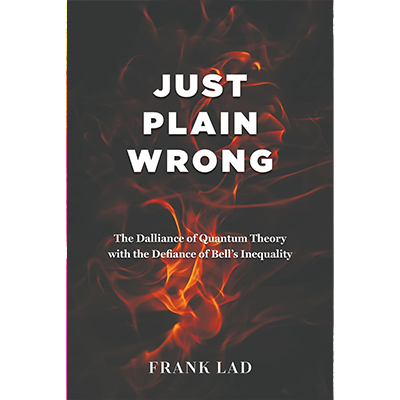 In this episode of Inside Personal Growth, host Greg Voisen sits down with Frank Lad to discuss his groundbreaking book, Just Plain Wrong: The Dalliance of Quantum Theory with the Defiance of Bell’s Inequality. Frank, a mathematician and probability expert, challenges long-standing scientific beliefs and exposes fundamental mathematical errors in quantum mechanics.
In this episode of Inside Personal Growth, host Greg Voisen sits down with Frank Lad to discuss his groundbreaking book, Just Plain Wrong: The Dalliance of Quantum Theory with the Defiance of Bell’s Inequality. Frank, a mathematician and probability expert, challenges long-standing scientific beliefs and exposes fundamental mathematical errors in quantum mechanics.
The Misconceptions of Bell’s Inequality
Frank Lad, a research associate at the University of Canterbury, has spent years analyzing the flaws in Bell’s Inequality, a fundamental principle in quantum mechanics that many physicists accept without question. In his book, he argues that the conventional interpretation of Bell’s Theorem is mathematically incorrect and rooted in a misunderstanding of probability theory.
Bell’s Inequality suggests that quantum mechanics supports non-locality, meaning that two entangled particles can influence each other instantaneously across vast distances. However, Lad’s findings reveal that this widely accepted theory is built upon an error of neglect, where crucial mathematical relationships were overlooked.
Einstein’s Stance and the Quantum Debate
One of the most fascinating aspects of this discussion is how Albert Einstein originally questioned the probabilistic nature of quantum mechanics. Einstein famously rejected the idea that “God plays dice” and believed there must be hidden variables that explain quantum behavior deterministically. Lad expands on this idea, showing that probability in quantum mechanics has been misunderstood for decades.
According to Lad, the scientific establishment has been resistant to challenging mainstream ideas, which has allowed errors in quantum mechanics to persist. He argues that the scientific community needs to embrace critical thinking and mathematical scrutiny to correct past misconceptions.
The Role of Probability and Hidden Variables
A key takeaway from Lad’s book is the importance of probability theory in understanding quantum mechanics. Rather than viewing probability as an inherent property of particles, he suggests that it represents our lack of knowledge about hidden variables. This perspective could revolutionize how we approach quantum physics, moving it from mysticism to rigorous scientific methodology.
Lad also introduces the idea that entanglement is often misinterpreted. Instead of two particles influencing each other instantaneously, he suggests that their behaviors are better explained by understanding the deeper statistical properties governing their interactions.
Challenging the Scientific Establishment
Lad’s findings have not been widely accepted in mainstream physics, largely because they challenge Nobel Prize-winning research. He highlights the difficulty of introducing new perspectives in a field that heavily relies on established dogmas. However, he remains committed to presenting his work at conferences and engaging in discussions with physicists worldwide.
He will be presenting his research at the American Physical Society Conference in March, where he hopes to encourage open dialogue among scientists.
Where to Learn More
If you’re intrigued by this discussion and want to dive deeper into Lad’s theories, you can explore his work here:
- Book: Just Plain Wrong – A detailed breakdown of his research and findings.
- ResearchGate Profile – Access his academic publications and mathematical analyses.
- LinkedIn – Connect with him for more discussions on quantum mechanics and probability.
Final Thoughts
This conversation with Frank Lad highlights the importance of questioning mainstream science and critically analyzing widely accepted theories. His work on Bell’s Inequality and hidden variables challenges some of the deepest assumptions in quantum mechanics and opens the door for future breakthroughs. Whether you’re a science enthusiast, mathematician, or simply curious about how the universe works, this is a discussion you don’t want to miss.
You may also refer to the transcripts below for the full transcription (not edited) of the interview.
Welcome back to Inside personal growth. This is Greg Voisen, the host of inside personal growth. I'm joining you from Encinitas, California, and on the other side of the world is Frank Lad. And Frank is joining us from Christ Church New Zealand, and he's going to be speaking with us about his new book called just plain wrong. Now, Frank, how are you doing this morning? It's morning there. It's afternoon here in Southern California.
That's good. I'm rocking over here. Everything's good.
I'm glad that you are and I'm going to let the listeners know a little bit about you. He's an advocate of the constructive mathematical viewpoint of Bruno D Finetti. Frank Lad is a research associate the Department of Mathematics and Statistics The University of Canterbury. He's the author of operational, subjective statistical methods, a mathematical philosophical and a historical introduction, which was a Wiley book in 1996 many journal publications in mathematics statistics are available on this pages at the Research gate.net that's Research gate.net These include extra P complementary Dual of entropy, statistical science, 2015 he's also the lecturer widely thought around the world, residing in Christchurch, as I said, and over there, he's got a very relaxed life. Well, Frank, thank you for taking this time today to be on insight, personal growth and talk about your new book. The total title of this book is just plain wrong, the dalliance of quantum theory and the defiance of Bell's inequality. So for those of you who are like going, Wow, how is Voisen? Has he gone mad? And he's uh, and he's interviewing Frank, I am, because sometimes I'm switching things up, and I think there's a lot that people can learn about you your book and what's going on. So really frank, let's start off with that. What really inspired you to write this book was there a specific moment or discovery that really prompted the evolution of this book?
Sure, yes, that there was very specific. It was a professional mathematician, and I'm mainly interested in probability. That's my biggest fundamental interest. And one time I was at a party recently, most not recently. It's 10 years ago now, where I met an old, old friend from I hadn't seen him for 40 years, I think, but he from graduate school days, he was a friend of my brothers, blah, blah, and from graduate school days, he had similar background to myself. He was a quality control engineer for a major eof people, and I mentioned that I didn't know anything about quantum physics. And they said, Oh, we don't know anything about it either. Let's start a study group, he said. So I got in, we started up the study group, and someone sorted out, what are the topics that everybody should prepare for? He said, I got the topic of Bell's inequality, and it's actually a very interesting problem, and I think you should look into it. So I said, I've got notes. I did all the research. I'll do all the background reading myself. I'll let you know what it's all about. And so I said, Sure, I'll look into it. And so we started correspondence, and that's how they got interested in the problem. I had never been interested in physics since high school, and the more I heard what physicists said about probability, the less interested I was. But I became interested in this problem.
Well, you know, you, with your background in, as you said, mathematics and statistics, it obviously interested you, and your book really challenges widely accepted interpretations of quantum mechanics and again, particularly Bell's inequality. Can you explain what you found to be, as you state the title of this book just plain wrong kind of in simple terms for the listeners, because you're actually rebutting what someone came up with as their theory, and you're saying, No, it's wrong. So what's wrong about it? And where are you able to explain that to our listeners in in kind of a simple sense,
sure, I can, I can I can explain what it's about. We'll need to talk a little bit background of what physics is about. Physics is a study of how things work. But what do you mean? How do things work? How do things work at the scale of our life, like rolling bowling balls and figuring out structures of buildings, how much load can a kind of a joint carry, and that sort of stuff, and then those at this at this scale, we're talking about things like meters and kilometers and centimeters and hundreds of kilometers. Well, there's also a scale of the planets in the universe. And there, we're not talking about 1000s of kilometers, we're talking about light years, billions of light years. These are huge, huge scales of time. And there's so there's the astronomical scale, there's what's called the classical scale, is the scale of our life, and then there's the quantum scale is the scale of tiny, tiny, tiny stuff. For example, we're talking about things like photons and electrons to an idea of how tiny we're talking about the mass of a photon. It's not grams or tenths of grams. It's point it's 10 to the minus 48 power grams, that is point 00001, grams. You're talking about tiny, tiny, tiny steps. Other things work down there. That's what quantum mechanics is about. Well, classical mechanics is the class is the mechanics of bowling balls. And there are two features of it that are very important, that are different, apparently, from quantum mechanics. And the things that are different are the bowling balls. If we roll a bowling ball down an alley, going at the pin set at this angle with this acceleration and spinning at this rate, the laws of physics will tell us what will happen. It'll say, Well, if you do it like that, you're going to get a 610 split if you get a 910 standing alone. Or laws of physics will tell you what happens. That's one feature. And the other feature is that if you're rolling your bowling ball and applying the laws of physics to your alley, you don't have to pay any attention to that. There's 50 alleys in this alley, and there's one immediately behind you, where somebody's bowling balls in the opposite direction. You don't have to pay attention to that. That's a feature that what's going on in your alley, the mathematics of physics is local. It depends on what's going on in here. Well, quantum physics, what we're doing we're not rolling bowling balls down an alley. We're sending photons down long tunnels, one meter long, one kilometer long tunnels. We send two photons in opposite directions to one observation station and to the other observation station, not a million photons like you see an out of coming out of your light bulb, just a single photon. And when the photon gets to these two stations, it's going to meet a polarizing material, just like your sunglasses. Your sunglasses, some light comes through and some doesn't come through. What makes a photon go through and not go through? That's what quantum mechanics is above, and the features of the mathematics are different from quantum from classical mechanics, in that the mathematics of quantum mechanics don't tell you whether the light, whether the photon, will go through the polarizer or not. That'll only tell you the probability that it will go through the polarizer. That's one feature of it. And the other feature is that it turns out, if you're sending photons in opposite directions, well as is currently understand, as as is currently understood, the activity of the photon at your polarizer depends on what's going on at the polarizer behind you. So they say that quantum, mechanics are not local. This was a feature that Einstein had objected to in the 1930s and that's how we get into bells inequality. But go ahead, yes. Well,
no, my question was, is so if Bell's inequality, and I think you need to kind of explain, explain that for the listeners, because that's important. You're saying that his theory is faulty. It's mistaken, yeah, it's mistaken, right? But it's going against Well, what's been around in the scientific community for a very, very long time? What is it that why is correcting the misunderstanding so important for the scientific community and beyond, and what are the broader implications of his heir?
That's okay. So there's a quite a number of questions there. So it goes like this, first, about Bell's inequality. If we do this experiment that we were just talking about, where he sends two photon in the opposite direction what the experiment does. The experiment takes place very fast, because these photons are traveling, of course, at the speed of light. Photons are light. Light is made up of pieces of stuff, little packets of energy. And they're going very fast to do this experiment, sending them down one one kilometer long tunnel that takes one nanosecond, is the whole time that this experiment takes place, and so, well, Bell's inequality was this. Einstein in the 1930s he was concerned about these probabilities of quantum physics. He says, What are these probabilities? What are they? He said, These are the probabilities are correct, yeah, if he was involved in developing the mathematics. But he said, What are these probabilities? Says, I can't believe that the probabilities are in the photons. Probabilities are not part of nature. His famous saying was, I can't believe that God rolls dice. That is, that this nature is the result of a of a random experiment. He says that something's something's going on here. We don't know exactly what it is, and probabilities represent our uncertainty about what's going on when we know some features of it, like we know the direction of the polarizers at the end of these two tunnels, we know that, but that's all that quantum physics is involved with. The probabilities don't represent the properties of the photons. They represent our uncertainties about things. Well, he got shouted down by Niels Bohr and what's called the Copenhagen view of quantum physics, and that which became the standard view, and it's the general view, many variations on these details, but that's the standard view. Well, in the 1960s John Bell, he was a young Irish physicist, and then he was a particle physicist. He worked at CERN, the salt pan de Research Nuclear that's, that's where he worked. And he was interested in these things. He was interested in Einstein's views, and he was trying to reconstitute how they might be relevant. And he came upon this problem. There was a, there's an inequality of quantum physics that if of the quantum probabilities, that if Einstein was right about the locality of quantum behavior, which has been rejected, but Feinstein was right. Then the probabilities of quantum physics to which Einstein subscribed seem to defy this inequality. And the way, what the how the inequality works is we have to think about an experiment that's it's actually an experiment that you cannot do. You can't do this experiment. It's these people are all Germans. They call protocol. It's what's called a gay Duncan experiment, a thought experiment. Here's the experiment you have. You're sending the photon in opposite directions to station A and B, and polarizing material has a direction to it. Polarized has the direction to it. You could set the direction of your polarizer up or down or at any angle you want, at a and any angle you want at B. Well, the polarizer, the experiment that you cannot do, you can send it to direction a and direction b, you can send it to direction a prime and direction b. You can send it to a prime and B prime. You can send it to a and b prime. You can send it to any one of these four directions, but you can't send them to all four at once. Well, suppose you could that we're going to do a thought experiment in that context. If you could do this polarizer, the result of the experiment, what are we going to see? The polarizers get set at one of these angle directional pairs, a B or a B prime or a B, it gets set at one of those, and once it sets, then we're going to observe. We have a photographic plates behind these polarizers, and we can tell did the light go through or didn't go through. We photon makes a little mark on the on the on the photographic plate. So what are we going to observe? The photons go through? Yes, yes, yes, no, no, yes, no, no, those are the four and the quantum mechanics to offs the probabilities of those four things. Well, yes, yes and no, no are both represented by one. And yes, no and no, yes are represented by minus one. So we do an experiment and the result is going to be one or minus one. Well, if you did all four experiments and you added those results together, you could get four plus ones, three plus plus ones and one minus one, two pluses and two minuses, two. And if you did all four Well, if you said four different photons and did that experiment four times the sum of those four things can be 420, minus two or minus four. But if you did the experiment with the same pair of photons that all four this gay Duncan experiment, they'll discover that you can only the sum can only be two or minus two, two or minus two. Now what's the result going to be? Well, it's random. The quantum mechanics tell the probability of two and the probability of minus two, and they make an expectation of the sum with the expectation of the sum better be between plus two and minus two. At some average of those two probabilities and and plus two and minus two, the expectation better be between minus two and plus two. Well, if, if quantum mechanics is not local, as Einstein claimed, then, it appears that the expectation of supplied by quantum mechanics is 2.8 it's not between minus two and plus two. That is the defiance of Bell's inequality. And that is what I'm in that's what I'm claiming in this book is wrong. They made a mistake in coming up with 2.8 so
you're saying that's the mathematical error of neglect that you mentioned in the book.
They forgot to note. Well, the error of neglect is that if these four things can only add up, each of them is plus one or minus one. If these four things can add up only to two or minus two, that means that if you added three of them, and you get into sum to three because you got 111, well then the fourth one's got to be minus one because it can only add up to two or minus two. If you got a one, one plus one, plus one, minus one, and three sum up to only plus one, then the fourth one's got to be plus one because it can only add up to two or minus two, all four. That's the error of neglect. They forgot to notice that there are functional relations among the four components of the sum that involved so. So
in your community, the scientific community, why has this persisted in this discourse for so long? I mean, you were talking about, didn't you say the 1950s I thought you said yes. So we're now in 2025 now you're saying that there's an error. Is anyone agreeing? Is anyone agreeing with you? I'll
answer, I'll answer that question. Because when, when the mistake was made, this mistake and neglect, the mistake was taken on as correct, and it came to be, came to be embedded deeper and deeper and deeper into the general understanding of quantum theory in the 1980 subsequent to John Bell, Who wrote, published this paper, 1965 1970 was John Clauser, who worked out the experiment, just in the way we had mentioned 1980 along comes Alan a spade and I French young guy. Also, he said, Wait, this great result of quantum physics, it's based on the thought experiment. Can't we get any real experiments that we're isn't this physics we're talking about we're not talking about dreams, we're talking about physics. I'm going to make going to make some experiments. So he did some experiments, and he did his experiments, and he concluded that, yes, he did his experiments, and he found out that the answer was 2.8 just defining just as I Bell's inequality. Said, Well, that was taken as correct, and then it was even expanded more and more and this the things that I have noticed this. Physicists have not studied them because they rely on once things get published in a paper, then people all refer to this paper. There's this paper, and that comes to be common knowledge. So people know, everybody knows, if I send my papers to the journal in American Physical Society journals, the editor won't even send it out for review because they say, we already know about this. You got to be crazy. These three people have won the Nobel Prize for this. We know about this. We're not going to, I'm not going to send this out for review. I'm not going to bother my reviewers to read this stuff that I know is wrong. We all know it's wrong because they they're they're interested by the magnificent
so it's entered the establishment, but it's true what you say that it is
wrong. It is wrong. You
critique Nobel Prize winning research in the book. And so I applaud you for your willingness to take this challenge on, because it's would seem like it's an uphill battle, but how does your approach challenge such? I know I hear what you're saying, highly regarded work that's been done, and as you said, it's been established, but people did, oversaw what really was happening. In other words, it's almost like they didn't try the experiment themselves, like this other scientists did and prove that they were wrong. So you do have some people in your camp, right?
That's not true. Many people have done this experiment. They've done it in different ways, with embellishments on it, and blah, blah, blah, and they've all made the same they've all been the same conclusion,
the same conclusion, and they're all saying that it is just playing wrong too.
Just the same conclusion, the same mistake. The same mistake is that there's an error of neglect that they neglected the functional relations. It's a mathematical mistake. And if you know basic mathematics at the college level, you will see the expect mistake, very simply, very and very clearly. If you're not familiar with the with the mathematics, still, people would be interested in and should be willing to know that even scientists can make mistakes. We can make mistake. We make mistakes. But science, they've made a mistake, and it's become embedded into physical theory because of their the enamor of the great the glories of these great physicists, yeah,
I can imagine that they've won prizes.
Me, the great physicist never interested me. What interested me was the problem. I didn't know these physicists were great. When I started studying the problem, I studied the problem and I got into it and I got into it. I said, there's something wrong here. And John Bell himself, he said, there's gotta be something wrong with this. He said, If the laws of physics are different at the small scale of 10 to the minus 48 power photons, gram photons. Then they are at the scale of bowling balls. Then there's got to be some scale at which the laws of physics change. And what could that scale be? Where they change? He said, very clearly. He said, Either we're going to find out, or as I suspect, we'll find out, that there's something wrong with this. I don't know what it is, but we're gonna, I suspect we'll find something wrong with it. And I'm saying somebody coming out of nowhere, not a physicist, the probably probabilist, a mathematician. I'm saying I found out what's wrong with it. This is what's wrong with it. Read the book, and you'll see that's what it is. And probably the error gets expanded and expanded and expanded, and I assess that error in seven different chapters that discuss many aspects in great detail. The fine, finest detail is not of interest to the general reader, but the idea of what's going on with the problem that should be of interest to the general reader. And I wrote it for general readers. It's fun, it's funny, it's remarks and and it's, it's mathematics, well,
and a lot of people love mathematics, and obviously, if the math, as you say, adds up, it's right. So you know, the book re revisits the ideas of the hidden variables in quantum mechanics. As you really said, how do the variables help explain some of the mysteries of this quantum behavior as what you're talking about? Because I think you've explained some of it. And I may be asking this question again, and you may feel like, Hey, I already answered this question. But maybe you could approach it in a in another way, where the people listening are like, okay, I get it. He really has said that these variables were the variables I get the variable about the photon and going to each end, and the mathematics of each of that. And I think you did a great job of explaining that. What could you add more to it? Or are we good with what you've already given
the thing. The thing about hidden variables is that they're hidden. People are trying to figure out what they are. There's a lot of there's a lot of people who are doing thinking, well, maybe this is going on, maybe that's going on, maybe that's going on. There's a whole literature about that, which this book does not discuss, that the variables are hidden, and we don't really know what they are yet. But the way that hidden variables work is, suppose that you did a bowling ball and you knew about the angle of the direction of the you knew about the angle of the direction of that which you're rolling the bowling ball. You knew the acceleration of the ball. You knew the regular the spin, but you didn't even think about, and you don't even know about the coefficient of friction of the bowling balling lane? Well, bowling balling lanes, when they're prepared and they're brand new, well, they had their life. They're like glass. They don't there's no friction at all. Well, there is some friction. There's no but, if you but now, this is a bowling ball where even you and me and all these robberies are bowling on the thing, and we're bashing the ball and, well, the code that bowling the surface of the bowling lane is not perfect. What is it? Right? Well, if you don't even think about that, well that's a hidden variable that, if you didn't think about that coefficient of friction, then you would find out that the laws of physics wouldn't tell you exactly what was going to happen, because they didn't have involved.
Now, that's a very good explanation that the average person who's listening to this can understand, because they haven't looked at the hidden variables. And I think if there's one thing they could take away from this interview is the fact that the hidden variables, all of them, need to be looked at to come up with the right formula to determine what's going to happen that's true with anything in life, right? You think I drive a car which is electric? Well, the good, the good. Here's another factor, right? This is, this is a simple one. I think my listeners would really get so all these electric cars say, Well, you can get 300 miles on a charge, right? Or they're close to it and but the reality is, it depends on the speed that you're driving at. It depends on the road resistance that you get, it depends on the weight that you're carrying in the car. It depends on all these variables. And everybody says, Well, my car didn't get the 300 miles. No, it didn't get the 300 miles because you had all of these other factors, and that battery that you're depending on is actually it's drawing much more energy to do that, so climbing a hill, doing all the things that it has to do, yeah, and I think that's a really great example for people to say I understand better. But the variables, because I can tell you one thing, I've never gotten 300 miles out of my 300 mile charge. And there are times when it can be disappointing, because you're like, oh boy, where's the charger, right? So, so let's look at it this way, you have this personal journey that you've taken on, and that's taking on and that's taking on this scientific establishment with your findings. Have you faced, and if so, I know you faced some resistance of the mysteries of the quantum behavior, or are people in acceptance of what you're actually articulating through your book and your talks and everything else.
Yeah, no, just generally, generally resistance, because people say we already know about this. I'm not even going to read your stuff. We know this is all these. We know about this, and we're not going to. Well, I'll tell you this, Greg, I'm a member of the American Physical Society, and this coming March in Anaheim, California, there's going to be a global meeting at the American Physical Society in which 15,000 physicists from around the world are going to come. And everybody, everyone who's a member of the Society of which I am a member, have a right to make a 10 minute presentation, whatever you want. There are all these categories. I mean, there's a huge booklet of what are all these talks you're going to be about? Well, I'm going to be there, and I'm going to talk for my 10 minutes. I will be able to talk even faster to these people, because the people who will be listening to my talk, they will know all about bells and inequality, all know about polarization of light. They will know about all this stuff, and I'll be able to talk even faster than I'm talking when I'm talking with you.
Well, you know, I'll have to come to that because I don't live that far from Anaheim, so you'll have to remind me, and I'll meet you in person.
That's okay. You'll have to pay $350 to get in the door. That's
okay. We can do that. Great,
okay, oh, I'll meet you in person. And I'm it's March 16 to 21st is this is the is the meeting, and I believe my talk is at 11am on March 17.
I believe it is that, is that this 2025 this coming March. Yes, yes. Okay, all right, so look for the lay person. Yeah, wanting quantum mechanics can seem somewhat esoteric. What would you say to someone who feels intimidated by this subject but is curious about its significance?
Okay, okay. Well, I'll say this. You know, when people send you get it, you get an email and says, Oh, Greg, congratulations, you. You've won $3 million that's been awarded to you by the United Nations survey for people who are interested in personal development, and we're all you have to do is to click on this, click on this reply and tell us your bank account number, and you'll be fine, right? Good to be true. And what people say about these scammers? If it sounds too good to be true, it is too good to be true. Well, I'd say this about people who think that you know what the you know. Some, not everyone, but them, some, a good number of these quantum physics peoples. I sent a paper to one place, and he said, anybody who don't, who knows, anybody who knows anything about quantum mechanics, has got to come to grips with the fact that when you're not looking at the moon, it's not there. Moon's not there unless you're looking at it. Meanwhile, the tides are the tides are pulling the ocean in and out, in and out. You're not looking at the moon. But these people, there's not just that. Then there's other people who say, Oh, there's not just this world we're living in. There's a whole bunch of worlds. There are many. It's called the many worlds hypothesis. They see, there's many, although all the ways the world could possibly be, well, it is all those possible ways, and we're just in one of them, but there are all these other ones too. These things are crazy. If you hear things about quantum physics, don't be my semester. I would say to someone who don't be intimidated by mathematics. Mathematics is a language. How about you? Do you speak French? Do you speak Hindustani? Do you speak Italian? Do you speak whatever language you'd like to talk about? You don't speak those languages well. You can't understand other people are saying those that's what mathematics is. Mathematics is a language. It's a language for talking about things. Some languages are talking are good for talking about some things and not for other things. Some are good for those other things, but they're not good for this thing. So that very good. Don't be intimidated.
Well, look,
go ahead, you have,
you have ideas you presented in the in your book, influences other fields, such as technology, you said philosophy or education. Can you speak with the listeners about that? I mean, the one you just talked about. You know, if you're not looking at the moon, well, then the moon's not there. The there are lots of those theories around what I would call quantum physics, right? So how can the ideas that you presented in this book influence these other fields, such as technology, philosophy or education,
I'd say, Well, aside from the details of what's wrong with the with the understanding of quantum physics per se, there's a there's another feature that's that the physicists refer to as the feature of entanglement, the entanglement of photons. This photons entangled with that photon. And it turns out that their sense of the entang of entanglement comes from their misunderstanding of the meaning of features of the probability distribution that characterizes the probabilities for Yes, yes, yes, no, no, yes, no, no. Those probabilities of yes, no are the same as the probabilities for No, yes. What these these two photons go through? That's a feature of symmetry of the of the probability distributions. Bruno de Finetti referred to those as exchangeability, exchange but we have exchangeable opinions about the behavior of these two photons, just like we have exchangeable opinions about the wheat yield of two acres of Kansas that are separated by 300 miles apart. Kansas looks the same everywhere. You know you're going through the Kansas. Well, it looks the same everywhere, but it's not the same everywhere. This is this one. There's that one. This one's close by to a close by to a nature reserve where all the birds come and hang out. That one's not What if you say, pull up, pull up. Two acres at random. You don't know which one is which. You don't know anything about that. Blah, blah, blah. So it's not that the acres are entangled. It's our opinions about the results of the two acres are entangled. And the same with our opinions about the the activity of the photons of these two at these
two Well, I think when we had our first one, I think one of the things our listeners could probably understand, and because you're a studier and a teacher of statistics, is the whole thing around predictive analytics. I know this isn't part of the book, per se, but this is something I think our listeners could understand a little bit better. What would you know when you talk about these probabilities? And I think this is a something very real for listeners to want to understand. And let's say an insurance company uses predictive analytics to say there's going to be fires in Los Angeles. So we're canceling all your homework. Let me just grab one another book. Hold on. Okay, do
I Okay, great, good, good. I'm back. I just want to pull up this other book. This other book is the major book of my professional career, operational, subjective, statistical methods, mathematical, philosophical and historical introduction now that book people can get in a library, any university library will have it, and many, many other libraries as well. You can get it still, if you can still get one, you know, a used copy online, I think, anyhow, blah, blah. The issues about issues about predictive analytics is this is that the objective theory of probability says nature is random. Things happen by chance. There's some probability that that that fire that started out last week and that we damp down, there's some probability that will jump up again. They say it's random whether it'll jump up or not. What we're interested in is the probability. The real things are the probabilities. What we need to do is to estimate the probabilities, then the way that we will estimate them, so we'll find out all the other fires in history that we know that are just like this fire, and find out, after they were down to the same how many of them started up again, how many of them? And we're going to estimate the probability that should Bruno definition, there is no probability. It's going to jump up, or it's not going to jump up. You don't know, I don't know. Your probability represents your uncertain knowledge. Mine represents mine. Neither of us are right or wrong. We're just saying what we think. But some people are informed by all sorts of other fires. Some people are not. And so your probability, that's where you are. This is where I am. Probabilities are not, are not things to be estimated because there aren't any probabilities. What we want to what we want to assess is, is there going to be a fire or not interested in estimating probabilities, we can do scored sequential forecasting. What that means is we make, we make forecasts of things that we don't know what's going to happen next. Easier example is, how about dairy cows? You have a herd of you got a herd of 1000 Holstein Friesian, pure, purebred dairy cows, and they're all heifers. They've just given birth their first child. How much milk are each of them we're going to give you don't know. I don't know we. Neither of us know, but your knowledge of dairy cows, you know something about dairy cows. You drink milk. You've seen a cow at the fair, at the county fair, you know they're big. How big are they? How much does the dairy cow weigh? You don't know. I don't know. My understanding is probably closer than yours, because I have studied things about dairy cows for my for my statistical reasons. But the point is, is that we don't know what the yields of these 1000 dairy cows are going to be tomorrow. Neither you nor I know we can put some probabilities for deserve my probabilities for these yields are this your probabilities are that. Now suppose that we can observe the first 10 dairy cows. This one bean milks twice a day. This one gave 90 pounds, that one gave 102 pounds. This one given how many? How many? How many milk is measured in pounds.
And I understand what you're saying. I guess my question might be, because there's a whole lot of believers out there and and a whole lot of people using artificial intelligence, which is collecting data and analytics from all over the internet, right? And so my question for you would be is, do you believe that people might be getting a little bit closer with this predictive analytics, with maybe a more reliable or an abundant source of data, and which is being fed in to something like AI, to come up with a mathematical model that might have more accuracy. And I mean, if you, if you go way back in time, we had a hard time getting those analytics from around the globe. Now we're able to, with pretty much the push of a button, come up with all kinds of mathematical analytics. What would your comment be, and what's one you're
right on? That's that's our hope, that we're that we would get better predictions of things that that interest us. What do you mean by better predictions? I just said that you have your opinions. I have my opinions. Probabilities represent our uncertain opinions. Well, if you're interested in finding out what you think or what I think. How about you express very carefully your opinions via probabilities for a sequence of observations and your problems are yours, mine or mine. How about if we give each of us a score when you you don't know exactly what's going to happen, so when what with the accident things would happen. You didn't say it was that or it wasn't that. You said it might be this might be this one. There are ways it's in the theory. They're called the Theory of proper scoring rules. This is a statistical theory that developed. It was mainly motivated by a really great American Statistician. Was Leonard Jimmy savage. He was called just before he died. This was his last work, but it's a, it's a, it's a topic that has developed and developed, and I'm quite interested by that. That's what we do. You make sequential forecasts. Somebody else makes different sequential forecasts. Well, let's score your forecast. Let's score my forecasts. I
see. Well, that brings, I mean, that kind of really gives the listeners a little bit more of understanding. Now, look, you've got this book, and to kind of wrap our interview up, you're taking people through this journey that you've done of just plain wrong, that the that bells inequality is is wrong. This theory,
this defense, is wrong. Well, the
defiance, the defiance of the quantum theory and the defiance of inequality, yeah. So tell me what is one big takeaway that a listener would get from your book just plain wrong. And what do you what do you hope it will be that, hey, really, people should question. People should look for the variables. People aren't looking for the variables. What might be the big takeaway for somebody who's average after they listen to this podcast?
Okay? Well, people who are looking at the variables, those are people who are doing experiments at the Nuclear accelerator in Europe and Stanford and all these various places. Those are the people who are dealing with the physical situation. What someone can take from this is to realize that science is not a bunch of facts that we know for sure and that science is a representation of our best, considered opinions of the people who've been studying this thing the most possible, much, much more than you have the people have been studying it, and they're communicating with each other. They're criticizing each other, they're discussing things. But scientists can be wrong. A mainstream idea can be wrong, and if, and if, it when you make a mistake, it's one thing to say, uh, is to say, Wow, I made a mistake. Wanting to learn something from the other one is to when someone points out the mistake, is to repress it, or repress it. We'll keep that stuff out of here. Don't let anybody read that kind of stuff. Well, I'm gonna No, no. That's when you make a mistake and someone points out the mistake to you. Then you think seriously about it, you might then say, Oh, well, your understanding my mistake is wrong for these reasons you can discuss, but be willing to discuss when you say, when you when you have an I have an idea, then you're living in terms of some world where you've put it all together in a certain way. When somebody challenges you think about it and discuss it and admit that you're wrong if you are wrong, and revise your opinion. That's what I think people should learn from and
that's a great takeaway for anybody, whether it was this theory or anything. It's really about life in general. Because you're saying, look at this side, look at that side, look at the variables, weigh out the differences. And in the end, we're all going to come up with our own opinion.
And many of us will agree. Many of us will agree. It's just because we doesn't make us right, but, but we and if you take take science seriously, unless you have something particular to say that's critical about it, well, you go with what the scientific opinion is.
Well, obviously, in this one Frank there was a consensus that bell was right. And you know, as you go down the road, and until you've kind of come along here, you're saying, yes, there's have actually challenged it as well, but you're challenging it in a big way by writing a book and saying, Hey, this, this is wrong, and I just want to acknowledge you for that, because, you know, there sometimes there aren't a lot of people that will stand up in the scientific community to do that. But do get, do get this book if you have interest in just plain wrong, the dalliance of quantum theory and the defiance of Bell's inequality. This would be a good book for you to read. You can get it off of Amazon. You can certainly that's the best place that you could go ahead and pick up a copy of this. Frank, it's been a pleasure having you on the show to speak about your book and your other book as well. And you might not be able to get that other book as readily, but he did mention it during our conversation here, and you could certainly get it at the university, or you'll probably find some used copies around as well. And I look forward to meeting you in March in Anaheim at the conference, and thank you for being on the show.
Yeah, good. Well, be in touch. Greg, thanks very much. I enjoyed talking with you.
I enjoyed it as well.
Sign up to receive email updates
Enter your name and email address below and I'll send you periodic updates about the podcast.











Leave a Reply